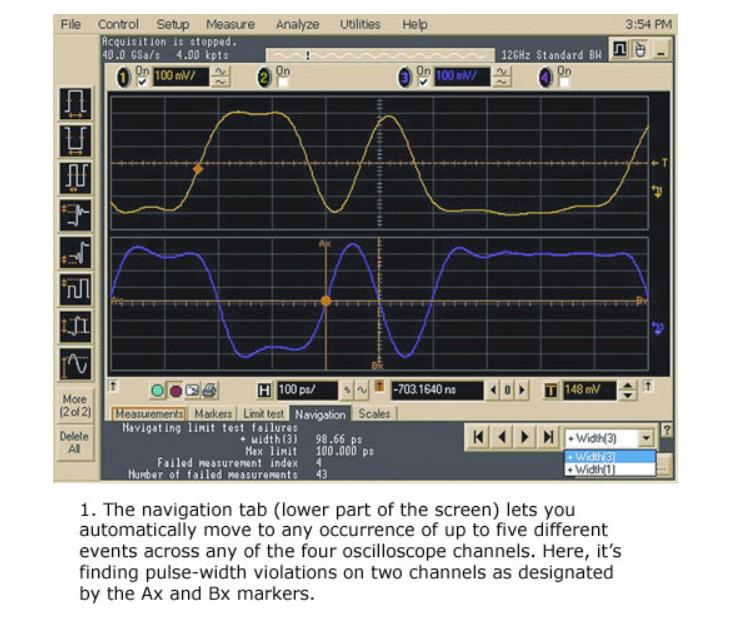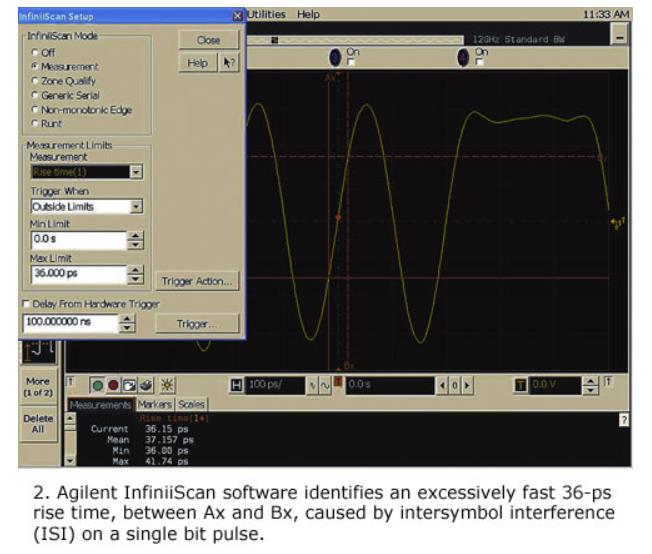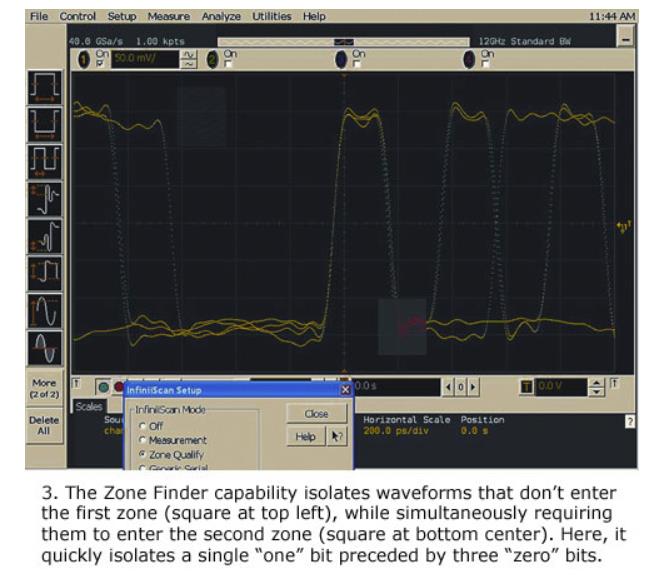In high-speed circuit design, the traditional method of locating signal integrity problems is to use hardware triggers to isolate the events, and/or use deep acquisition and storage technology to capture the events, and then look for the problem. As the speed and complexity of high-performance circuit systems continue to increase, the limitations of using oscilloscopes to locate signal integrity problems are gradually becoming prominent.
With the emergence of a new event location technology, this situation will be greatly changed. Ultimately, this powerful event location system will effectively help design engineers find signal integrity problems quickly and easily.
Traditional signal integrity problem location method
Traditional hardware trigger/deep acquisition and storage methods have two major advantages in locating signal integrity problems.
First of all, there is no dead time when using hardware trigger to lock a related event. The hardware trigger system will keep the oscilloscope acquisition system running until the target event is found. Once the target event is locked, the hardware trigger circuit will trigger to complete the data acquisition work of the oscilloscope, and the event will be displayed in the center of the screen at the same time. This method is indeed very convenient.
Secondly, using deep acquisition and storage technology, users do not need to know the types of signal integrity problems faced by the target system. They only need to set the oscilloscope to the maximum storage mode, and set the trigger mode to edge trigger or even automatic trigger, and then let the oscilloscope Just start running. The oscilloscope will capture a relatively long screenshot of the execution of the target system, and then the user can analyze this data at any time to determine whether there is a problematic event. This technique is also called "swallow and wallow" technique.
These methods of using oscilloscopes to verify designs are very effective and have been deeply rooted in the community of electronic design engineers. But compared with emerging technologies in the test/measurement industry, this approach has many limitations.
New method to locate signal integrity problems
The new method of locating signal integrity problems is an event recognition software. Event recognition software is essentially a kind of intelligent software. This software scans the waveform captured by the oscilloscope to find out various signal integrity problems or events with signal problems. This method does not have the "no dead time" feature of the hardware trigger method. This is because there is inherent "dead time" when post-processing the previously captured data, and it does not have the "wide range" provided by deep acquisition and storage technology. The ability to save and investigate. But event recognition software has some unique advantages as follows, which are attracting more and more oscilloscope users.
1. Simultaneous monitoring of multiple events: The hardware trigger method can only identify one problematic event, and the hardware trigger circuit is set to trigger when a specific event occurs, which fundamentally eliminates the possibility of monitoring multiple events at the same time. The event recognition software is not affected by this limitation. The software can be programmed to scan 5 events on any channel or multiple channels at the same time. This can greatly reduce the time it takes to gradually narrow the range of potential causes of signal integrity problems and isolate intricately related events.
2. Find out the situation where the same event occurs multiple times: The hardware trigger circuit can only identify a single occurrence of an event per capture. In fact, before or after the event is isolated by the hardware, the event will appear repeatedly, but the hardware trigger method cannot find these recurring events. Event recognition software can do this, it can find out all occurrences of events captured by the waveform memory. Therefore, design engineers can find not only the first failure, but also the second and third failures.
3. Event navigation: Once the user has captured a long waveform through deep storage, the next step is extremely boring and error-prone manual work, which is to play back these waveforms, check each segment of the waveform, and find potential signal integrity problems. In-depth collection and storage technology can collect information on 10,000 screens. It is impractical to review all this information manually. Sending these oscilloscope data to a controller and writing customized software to analyze these data is also unrealistic and time-consuming. Once the event recognition software has identified all the occurrences of the target event, it can switch back and forth between multiple occurrences of the event using the intuitive playback control keys of a DVD player. Figure 1 is a test example using Agilent DSO81304B oscilloscope.

Figure 1: The navigation bar (the lower part of the screen) can automatically move to any one of up to 5 different events (in any one of the four oscilloscope channels). The oscilloscope in the figure is looking for the difference in pulse width between the two channels labeled Ax and Bx.
4. Identify multiple events: A typical hardware trigger system can isolate about 10 different types of events or trigger modes. But developing a new hardware trigger mode is very troublesome for oscilloscope manufacturers, requiring a lot of development resources and expensive IC production costs. In comparison, the cost of developing event recognition software will be much less. The current event recognition software can isolate any event that can be measured by waveform measurement (modern oscilloscopes can perform more than 30 waveform measurements), and can also find problematic events such as non-monotonic edges caused by incorrect signal terminals. It is almost impossible to use a hardware trigger circuit to trigger small waveform phenomena such as non-monotonic edges.
5. Identify the speed of events: The speed of the hardware trigger circuit is mainly affected by the speed of its transistors, and it uses analog technology. Now the most high-end hardware trigger circuit can achieve as low as 300ps pulse width (or pulse interference) trigger, and 3.25Gbps serial triggering (serial triggering). Although these indicators are excellent, the speed of the hardware trigger circuit still can't keep up with the speed of over 8.5Gbps of today's top system. Event recognition software is only limited by the sampling rate of the oscilloscope, and essentially uses digital technology. The sampling rate of the industry-leading oscilloscope is as high as 40GSps, and the speed of recognizing events through the software event recognition system is much faster than the hardware trigger mode. The new technology can observe events with a pulse width of 70ps, and its sequence search speed can reach 8.5Gbps (see another high-speed signal test example shown in Figure 2).

Figure 2: Agilent InfiniiScan software can identify the 36ps ultra-fast rise time between Ax and Bx caused by the inter-symbol interference (ISI) of a single-bit pulse.
6. Resolution of distinguishing events: The time resolution of hardware trigger circuits is relatively low. According to different trigger events, waveform signal characteristics, and specific waveform activities that lead to the trigger event, the resolution is about tens or even hundreds of picoseconds. When some more accurate indicators need to be measured, this resolution can no longer meet the requirements (that is, false faults may occur). As the software event recognition is purely digital signal processing, DSP technology such as 1 to 16 sampling point interpolation algorithm can be used to effectively improve the event resolution. The inspection of event pass rate can be increased to picosecond level. Figure 2 shows the waveform when the oscilloscope recognizes the rising edge of 36ps.
7. Visible can be isolated: The most attractive aspect of event recognition software is its "Zone Finder" function. Many oscilloscope users will see occasional intermittent signals flashing on the screen, but it is too late to press the stop button to lock them. Usually in this case, the user will set the oscilloscope to single acquisition mode, and then keep pressing the single trigger key (sometimes it needs to be pressed very many times) to effectively capture an event. In most cases, the result of this will only make your fingers sore. The area detector allows the user to draw an area on the screen. The user can observe the intermittent signal flashing in this area. When the waveform of this signal flashes over this area next time, the oscilloscope will automatically stop and display the waveform clearly. . Figure 3 shows an example with two areas. This feature is usually very useful.

Figure 3: The interval finder function can isolate the first area (the square area in the upper left corner) that has not entered, while at the same time the waveform of the second area (the square area in the lower center position) is required. The oscilloscope in the figure can quickly isolate a single "1" bit with three "0" bits in front.
8. Synchronize with hardware trigger: Through the programmable delay mechanism, the event recognition software can be used in conjunction with the hardware trigger mechanism. In other words, this method can capture software-defined events that occur when the defined hardware event is delayed for a specified period of time. This software and hardware combination system can generate a trigger sequencer, or hardware can be used to limit the waveforms to be checked by the software, thereby improving efficiency.
Event recognition software is an effective supplement to traditional hardware triggering or deep acquisition and storage methods for identifying signal integrity problems. When the oscilloscope does not have the "dead time" problem, that is to say, when the frequency of events is greater than once per second (one second is a long time for high-speed circuits), the new technology of event recognition software will become positioning One of the most effective and flexible tools for signal integrity issues in electronic design.